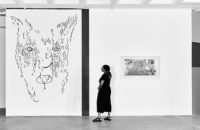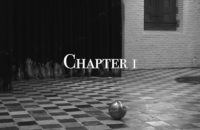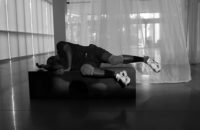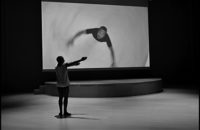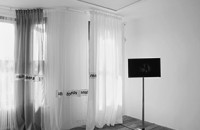Paul Maheke’s ‘Vanille Bleue’
Goodman Gallery
15.04 – 26.05.2021

Paul Maheke’s ‘Vanille Bleue’ plays with the concept of healing through its use of material, text, light-play, shadow, scale, colour and space. It is a departure from his dance- and performance-based work , yet the exhibition choreographs movements, repositioning fragments of history, poesis, healing modalities, the metaphysical, text, drawing, and materials such as copper.
Comprising immersive installation works, ‘Vanille Bleue’ features large scale drawings that have been rendered on the gallery’s wall, water droplet-like handblown glass lamps and rattan lanterns that are accompanied by an audio component in one of the blue-painted partitioned rooms. The theme of water and healing runs through the work.
Fabric curtains are installed across the exhibition space and function as a palimpsest and a bearer of speculative text pieces of Maheke’s inner world. They act as a performance prop for viewers to see through, delineating space and choreographing our movements. Like the sculptural works in handblown glass, the curtain-like installations interact with the light in the space. Together they give a sense of continuity to the theme of water. The material catches the light like the shimmer of the moon on water.
By incorporating text into the exhibition Maheke offers an additional voice for his works to communicate. He is interested in looking at the relationship that we have to one another. The work is rooted in ideas of decoloniality – he cites scholars such as Édouard Glissant – particularly where language and relationality are concerned as written in the exhibition statement. The relationship between decoloniality and healing is evinced in his preoccupation with his play on the textual, using what he terms, ‘one of the most oppressive structures, language, to communicate various meanings’. He adopts a poetic style in work such as As Saturn And Jupiter Conjunct. Digitally printed on four curtains, the work talks to how we relate to our surroundings, each other and the material/immaterial forms of the universe. Thinking about the immaterial forces that are impacting our physicality speaks to the broader context of how the artist is thinking about healing and experiences of healing.
A sound work accompanies an installation of a wicker lantern in a dimly lit cordoned-off space. The soundtrack is composed with frequencies that are emitted by planets, ‘frequencies we don’t hear as we have integrated them as our daily soundscape.’ Maheke hones in on how it is these very sounds that are reused and amplified by people in order to do healing work.
Maheke is occupied with the materiality of an object, and how its latent properties can provide us with healing, albeit it may not be its intended function. His use of frequencies that are used in other avenues of varied healing modalities – that mimic the sound of the universe or are the sound of the universe – explores the idea of collective healing in this current time. The idea that copper has a healing impact on the body, is well known within healing communities that Maheke references in his exhibition. His use of copper in works such as, The light was casting images of random narratives that some attributed to him, is made manifest of this observation about this material in the work, which has been touted as having a healing effect on the body and some believe spiritually too. It is believed to help control one’s sense and keep away negativity. I’d like to think that the work offers the same for the viewer who moves through the space just as it does for its wearer.
The idea of frequencies highlights how the intangible affects our physical spaces. The immaterial forces that we engage with on a daily basis, that we pay no mind to but have real effects on our bodies, mental states and affect how we show up in the world. The invisible and speculating about things unseen, articulates and reveals these forces through the large ghostly spectacles of the drawings, the abstract copper works and the frequencies and the installations.
It is this idea of the immaterial having an effect on us that I would like to hightlight: how inanimate objects do dance and the choreography and movement of objects in the exhibition. Not in the literal sense but through the poetics of space, themes of water, flowing states.
My preoccupation with the healing aspect of the work, is not only in the manner in which the objects and their materiality throughout the exhibition choreograph a sense of movement, but rather toys with the ideas that Maheke has planted, how does the invisible affect the physical and our bodies. Objects have presence and in turn their presence affects the physical spaces that they inhabit and by extension us too.
The exhibition alters and adapts throughout its duration,. Going beyond his past focus of emancipatory and decolonial aesthetics, Maheke foregrounds healing , objecthood, and the poetics of relationality in ‘Vanille Bleue’. These are intimacies that could potentially bring us closer through this period of distancing and isolation, but what can ultimately bring us healing as well.
A review by Nikita Keogotsitse on the 2nd of June 2021.


























